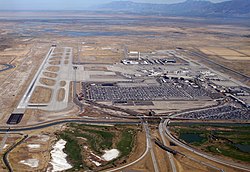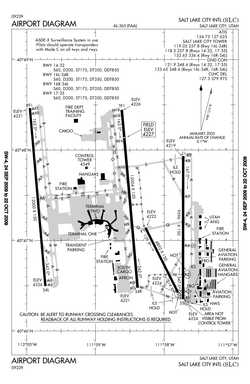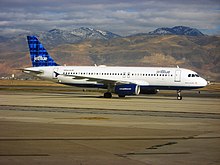Salt Lake City International Airport
| Salt Lake City International Airport | |
|---|---|

|
|
| Characteristics | |
| ICAO code | KSLC |
| IATA code | SLC |
| Coordinates | |
| Height above MSL | 1288 m (4226 ft ) |
| Transport links | |
| Distance from the city center | 9 km west of Salt Lake City |
| Street | I-15 / I-80 / I-215 |
| Local transport |
Light rail : TRAX bus : UTA route 453/454/551 |
| Basic data | |
| opening | 1911 |
| operator | Salt Lake City Department of Airports |
| surface | 3116 ha |
| Terminals | 3 |
| Passengers | 26,808,014 (2019) |
| Air freight | 194,974 t (2019) |
| Flight movements |
344,715 (2019) |
| Employees | 35,290 (2013) |
| Runways | |
| 14/32 | 1491 m × 46 m asphalt |
| 16R / 34L | 3658 m × 46 m concrete |
| 16L / 34R | 3658 m × 46 m asphalt |
| 17/35 | 2925 m × 46 m asphalt |
The Salt Lake City International Airport is the international airport of Salt Lake City in the US state of Utah . It is an aviation hub for Delta Air Lines .
Location and transport links
Salt Lake City International Airport is eight kilometers west of downtown Salt Lake City. The passenger terminal has its own junction on Interstate 80, which runs south of the airport . Interstate 215 runs east of the General Aviation Area and the Utah Air National Guard base . In addition, Interstate 15 runs several kilometers east of the airport site.
Salt Lake City International Airport is integrated into local public transport by a light rail line and several bus routes operated by the Utah Transit Authority . The Green Line of the light rail TRAX connects the airport with the center of Salt Lake City. The airport is also regularly served by bus routes 453, 454 and 551.
history
The airport's beginnings lie on a small airstrip that was opened in 1911. The site was later expanded by 40 hectares to make room for additional buildings. In 1920 the airfield was named Woodward Field and airmail flights began. The first commercial passenger flight took place in 1926. The airport was renamed Salt Lake City Municipal Airport in 1930 . It was also expanded by 121 hectares of land and a second runway . In 1933 the first administration building was erected on the airport grounds. In 1933 or 1943 a third runway was opened. In 1943 the airport became a training base for the United States Army Air Forces . In 1950, all runways were improved, the primary runway also received an instrument landing system . In 1953, construction work began on the future Terminal 1.
Terminal 1 was opened in 1960. In 1968 the airport was renamed Salt Lake City International Airport . Terminal 2 was opened in 1978, where Western Airlines flights were handled. In the same year, a general aviation terminal was completed and the western runway and taxiways were also expanded. In 1981 Terminal 1 was expanded and in the following year Salt Lake City International Airport became a hub for Western Airlines. In 1984 Terminal 2 was expanded to include an additional concourse. In December 1986, Western Airlines was taken over by Delta Air Lines and went on April 1, 1987 in this, so that the Salt Lake City International Airport became a hub of Delta Air Lines. In 1992 SkyWest Airlines opened a hangar and training center. In 1995 a third runway, Concourse E and the international terminal was built. In 1998 UPS Airlines became the first leaseholder of a freight terminal on the northern apron. 1999, a new went FAA - tower into operation.
In 2012 the mayor of Salt Lake City announced that he wanted to completely demolish the passenger terminals due to their low capacity and lack of earthquake security and replace them with a new terminal. The Airport Redevelopment Project began in 2014. The end of 2015, the project, the value of which 1.8 billion was US dollar amounts, officially presented. The project, which is divided into three phases, is scheduled to be completed in 2024, although parts of the new passenger terminal are to be commissioned as early as 2020.
Airport facilities
Salt Lake City International Airport covers an area of 3,116 hectares.
Runways
Air traffic at Salt Lake City International Airport is handled via four runways , all of which run in a north-south direction. The longest runway 16L / 34R is 3658 meters long, while the parallel runway 16R / 34L is 3658 meters long. Since the distance between the two parallel tracks is 1876 meters, they can be operated in parallel. The eastern runway is marked 17/35 and is 2925 meters long. The shortest runway 14/32 is 1491 meters long and lies between the runways 16L / 34R and 17/35. All runways are 46 meters wide. The runway 16R / 34L is paved with concrete, while the other three runways are paved with asphalt. Due to its length, runway 14/32 can only be used by general aviation and small cargo planes. The runway 17/35 is used for general and military aviation. In addition, the helipads HB and HF are located in the general aviation area , both of which are 18 meters long and wide.
Passenger terminals
The Salt Lake City International Airport has three terminals with five departure halls ( Concourse CG) and 71 boarding gates . As a rule, the international terminal is not counted as a separate terminal, so the number of passenger terminals is given as two. At times the number of gates was 86, but was reduced by construction work for the new passenger terminal. Departure halls F and G are located in Terminal 1. The departure halls used to be called B and A, but were renamed as part of the construction of the new passenger terminal. The terminal is used by all airlines, but not mainly by Delta , for domestic flights. Terminal 2 is used exclusively by Delta and the feeders serving Delta for domestic flights. Departure halls C to E are assigned to this terminal. The third terminal is used for international flights that require entry controls. These are essentially flights from Mexico. For flights from Canada, the controls are usually carried out at the departure airport (see United States Border Preclearance ), so that they are processed like national flights.
New passenger terminal
The old passenger terminals will be replaced by a new passenger terminal with two departure halls by 2024; these departure halls will be labeled A and B. The first parts of the new passenger terminal are scheduled to go into operation as early as 2020. Concourse B will be located on the apron as a satellite and connected to the concourse by a tunnel. Concourse A is to have a total of 47 gates in 2024 , while Concourse B is to be equipped with 31 gates.
Freight terminals
The freight terminals are spread over two aprons. One is north of the passenger terminals, the other south of it. On the northern apron there are freight terminals from FedEx and UPS Airlines . On the southern apron there are freight terminals for the United States Postal Service , Delta Air Lines and SkyWest Airlines .
military
To the east of runway 17/35 is the Roland R. Wright Air National Guard Base of the Utah Air National Guard with an area of 55 hectares. On this the 151st Air Refueling Wing is stationed, with which tanker aircraft of the type Boeing KC-135R is equipped.
Other facilities
The general aviation area is east of runway 17/35.
SkyWest Airlines operates a hangar and training center at Salt Lake City International Airport. Delta Air Lines also has a hangar. These facilities are located north of the passenger terminals.
Airlines and Destinations
Salt Lake City International Airport has served Delta Air Lines as an aviation hub since the merger with Western Airlines . It is served by a total of eight airlines on scheduled flights , without taking regional airlines into account separately . Delta Air Lines, including Delta Connection with 72.5 percent, has by far the highest market share among passengers , followed by Southwest Airlines with 9.6 percent, American Airlines including American Eagle with 5.6 percent, United Airlines including United Express with 4, 6 percent, Jetblue Airways with 2.8 percent, Alaska Airlines including Horizon Air with 2.4 percent and Frontier Airlines with 1.8 percent.
A total of 88 national and eleven international destinations are served directly. However, four of the national destinations are only served seasonally. Virtually all major US airports can be reached without changing trains. In June 2008, the first intercontinental route in the history of the airport opened with flights to Paris-Charles-de-Gaulle . Delta Air Lines now also offers intercontinental flights to Amsterdam and London Heathrow .
statistics
In 2018, the airport was ranked 23rd among the largest US airports and 85th worldwide in terms of passenger numbers. According to its own information, a total of 25,554,244 passengers were counted. If you look at the number of flight movements, the airport was 23rd (national) and 49th (worldwide) in 2018. For an airport of this size, Salt Lake City handles an unusually large amount of general aviation traffic, that is, sport flights and the like. The airport also advertises its comparatively high punctuality.
Traffic figures

| year | Passenger volume | Air freight ( tons ) | Airmail (tons) | Aircraft movements (with military) |
||
|---|---|---|---|---|---|---|
| National | International | total | ||||
| 2019 | 25,692,153 | 1,115,861 | 26,808,014 | 176.113 | 18,861 | 344,715 |
| 2018 | 24,482,284 | 1,071,960 | 25,554,244 | 177,599 | 18,613 | 337.276 |
| 2017 | 23.285.188 | 913,628 | 24.198.816 | 173.364 | 16,826 | 327.292 |
| 2016 | 22,395,720 | 759,807 | 23.155.527 | 160,457 | 13,797 | 320.149 |
| 2015 | 21,583,382 | 557,644 | 22.141.026 | 153.998 | 16,715 | 311,859 |
| 2014 | 20,770,994 | 370.616 | 21.141.610 | 149.055 | 12,805 | 324,957 |
| 2013 | 19,831,079 | 355.395 | 20.186.474 | 152,706 | 13,606 | 330,576 |
| 2012 | 19,741,800 | 360.278 | 20.102.078 | 156.128 | 11,217 | 328.130 |
| 2011 | 19,968,536 | 420.938 | 20,389,474 | 150.122 | 8,016 | 357.996 |
| 2010 | 20,427,176 | 474.357 | 20,901,533 | 140,641 | 4,800 | 362.294 |
| 2009 | 20,000,914 | 431,304 | 20,432,218 | 131,269 | 4,333 | 372,300 |
| 2008 | 20.337.176 | 453.224 | 20,790,400 | 156.319 | 4,271 | 389.317 |
| 2007 | - | - | 22.045.233 | 172.817 | 4,929 | 422.010 |
Busiest routes
| rank | city | Passengers | airline |
|---|---|---|---|
| 1 | Denver , Colorado | 761.460 | Delta , Frontier , Southwest , United |
| 2 | Los Angeles , California | 656.280 | Alaska , American , Delta, Southwest, United |
| 3 | Atlanta , Georgia | 596.150 | delta |
| 4th | Phoenix – Sky Harbor , Arizona | 566,860 | American, Delta, Southwest |
| 5 | Seattle / Tacoma , Washington | 549.630 | Alaska, Delta |
| 6th | Las Vegas , Nevada | 482,890 | Delta, Frontier, Southwest |
| 7th | Dallas / Fort Worth , Texas | 464.090 | American, Delta |
| 8th | New York – JFK , New York | 364.060 | Delta, Southwest |
| 9 | San Diego , California | 352,530 | Alaska, Delta, Southwest |
| 10 | Portland , Oregon | 349,370 | Alaska, Delta |
Incidents
- On November 11, 1965, a was Boeing 727-22 of United Airlines ( air vehicle registration N7030U) landing at the airport Salt Lake City International plenty flown too high, after the captain increased the rate of descent far beyond the permissible extent. An attempt by the first officer to increase the thrust was stopped by the master. The aircraft hit the runway at a high rate of descent, the main landing gear broke and tore a hole in the fuselage, whereupon a fire broke out. 43 of the 91 people on board were killed.
- On December 18, 1977, a Douglas DC-8F-54 "Jet Trader" (N8047U) of United Airlines flew on a cargo flight due to an error in the electrical system holding patterns over Salt Lake City . For a period of seven and a half minutes, the pilots interrupted radio contact with air traffic control in order to coordinate the further course of action with United Airlines technicians on a different radio frequency. During this time the machine flew into a mountainous area. When radio contact could be re-established, the air traffic controller on duty instructed the crew to immediately make a left turn and climb up. Seconds later, the DC-8 crashed into a mountain slope at an altitude of 2200 meters. The three-person crew was killed (see also United Airlines flight 2860 ) .
Web links
- Official website of the airport (Engl.)
- Airport data on World Aero Data ( 2006 )
Individual evidence
- ↑ a b c Airport History. SLCAirport.com, accessed May 16, 2018 .
- ↑ a b AirportIQ 5010: Salt Lake City International. GCR1.com, accessed July 6, 2019 .
- ↑ a b c d e f g Air Traffic Statistics. SLCAirport.com, accessed May 3, 2020 .
- ↑ Economic Impact Analysis Salt Lake City International Airport January 2013. SLCAirport.com, January 2013, accessed on May 16, 2018 .
- ^ Public Transportation. SLCAirport.com, accessed July 5, 2019 .
- ^ Schedules and Maps. RideUTA.com , accessed July 5, 2019 .
- ^ Salt Lake City destroys the airport. aeroTELEGRAPH.com, January 31, 2012, accessed March 25, 2017 .
- ↑ Salt Lake City gives itself a freshening up. aeroTELEGRAPH.com, October 14, 2015, accessed March 25, 2017 .
- ↑ a b c d e f Salt Lake City International Airport Master Plan. SLCAirport.com, accessed July 6, 2019 .
- ^ A b The New SLC: Rebuilding for the Future. SLCAirport.com, accessed July 6, 2019 .
- ↑ SLC Airport Overview. SLCAirport.com, accessed July 6, 2019 .
- ↑ a b c d SLC Fast Facts. SLCAirport.com, accessed July 5, 2019 .
- ↑ SLC Fast Facts. SLCAirport.com, accessed July 6, 2019 .
- ↑ Airport Terminal Map. SLCAirport.com, accessed July 6, 2019 .
- ^ Airline Flight Information. SLCAirport.com/, accessed May 3, 2020 .
- ^ Delta Launches First Trans-Atlantic Flight from Salt Lake City with Nonstop Service to Paris. News.Delta.com , January 2, 2008, accessed July 6, 2019 .
- ↑ a b Flight Schedule. SLCAirport.com, accessed May 3, 2020 .
- ^ North American Airport Traffic Report. ACI-NA.org , accessed on May 3, 2020 .
- ^ Salt Lake City, UT: Salt Lake City International (SLC). Transtats.BTS.gov , accessed May 3, 2020 .
- ↑ accident report B 727-100 N7030U , Aviation Safety Network (English), accessed on February 4 of 2019.
- ↑ accident report DC-8-54 N8047U , Aviation Safety Network (English) retrieved on 8 November of 2019.



